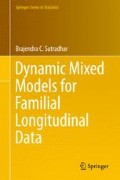Abstract
Recall that in Chapter 6, a class of correlation models was discussed for the analysis of longitudinal count data collected from a large number of independent individuals, whereas in Chapter 4, we discussed the analysis of count data collected from the members of a large number of independent families. Thus, in Chapter 4, familial correlations among the responses of the members of a given family were assumed to be caused by the influence of the same family effect on the members of the family, whereas in Chapter 6, longitudinal correlations were assumed to be generated through a dynamic relationship among the repeated counts collected from the same individual. A comparison between the models in these two chapters (4 and 6) clearly indicates that modelling the longitudinal correlations for count data through a common individual random effect would be inappropriate. If it is, however, thought that the longitudinal count responses may also be influenced by an invisible random effect due to the individual, this will naturally create a complex correlation structure where repeated responses will satisfy a longitudinal correlation structure but conditional on the individual random effect.
Access this chapter
Tax calculation will be finalised at checkout
Purchases are for personal use only
Preview
Unable to display preview. Download preview PDF.
References
Blundell, R., Griffith, R., & Windmeijer, F. (1995). Individual effects and dynamics in count data. Discussion paper 95-03. Department of Economics, University College London.
Hansen, L. -P. (1982). Large sample properties of generalized method of moment estimators. Econometrica, 50, 1029−1054.
Hausman, J. A., Hall, B. H., & Griliches, Z. (1984). Econometric models for count data with an application to the patents-R and D relationship. Econometrica, 52, 908−938.
Jiang, J. (1998). Consistent estimators in generalized linear mixed models. J. Amer. Statist. Assoc., 93, 720−729.
Jowaheer, V. & Sutradhar, B. C. (2002). Analysing longitudinal count data with overdispersion. Biometrika, 89, 389−399.
Jowaheer, V. & Sutradhar, B. C. (2009). GMM versus GQL inferences for panel count data. Statist. Probab. Lett., 79, 1928−1934.
Lewis, P. A. W. (1980). Simple models for positive-valued and discrete-valued time series with ARMA correlation structure. In Multivariate Analysis, ed. P. R. Krishnaiah, pp. 151−166. Amsterdam: North Holland.
Mallick, T. S. & Sutradhar, B. C. (2008). GQL versus conditional GQL inferences for nonsttaionary time series of counts with overdispersion. it J. Time Series Anal., 29, 402−420.
McKenzie, E. (1986). Autoregressive moving-average processes with negative binomial and geometric marginal distributions. Adv. App. Prob., 18, 679−705.
Montalvo, J. G. (1997). GMM Estimation of count-panel-data models with fixed effects and predetermined instruments. J. Busi. and Econo. Stats., 15, 82−89.
Prentice, R.L. & Zhao, L.P. (1991). Estimating equations for parameters in means and covariances of multivariate discrete and continuous responses. Biometrics, 47, 825−839.
Sutradhar, B. C. (2003). An Overview on Regression Models for Discrete Longitudinal Responses. Statist. Sci., 18, 377−393.
Sutradhar, B. C. (2004). On exact quasilikelihood inference in generalized linear mixed models. Sankhya, 66, 261−289.
Sutradhar, B. C., Bari, W. (2007). On generalized quasilikelihood inference in longitudinal mixed model for count data. Sankhya, 69, 671−699.
Sutradhar, B. C. & Jowaheer, V. (2003). On familial longitudinal Poisson mixed models with gamma random effects. J. Multivariate Anal., 87, 398−412.
Thall, P. F. & Vail, S. C. (1990). Some covariance models for longitudinal count data with overdispersion. Biometrics, 46, 657−671.
Wooldridge, J. (1999). Distribution-free estimation of some non-linear panel data models. J. Econometrics, 90, 77−97.
Author information
Authors and Affiliations
Corresponding author
Rights and permissions
Copyright information
© 2011 Springer Science+Business Media, LLC
About this chapter
Cite this chapter
Sutradhar, B.C. (2011). Longitudinal Mixed Models for Count Data. In: Dynamic Mixed Models for Familial Longitudinal Data. Springer Series in Statistics. Springer, New York, NY. https://doi.org/10.1007/978-1-4419-8342-8_8
Download citation
DOI: https://doi.org/10.1007/978-1-4419-8342-8_8
Published:
Publisher Name: Springer, New York, NY
Print ISBN: 978-1-4419-8341-1
Online ISBN: 978-1-4419-8342-8
eBook Packages: Mathematics and StatisticsMathematics and Statistics (R0)

